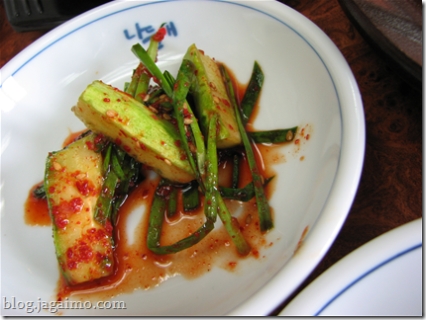On my two previous trips to Korea, I've been to locations of Pulhyanggi at least twice. (A friend once took me to a similar style of restaurant for lunch, but I wasn't quite sure of the name).
It's easily the most remarkable place I've eaten in Korea.
I couldn't imagine going to Seoul without eating there again, and I really wanted Hiromi to have a chance to try it, so we made plans to eat dinner there on Saturday night. With the help of our hotel staff, we obtained written instructions to give to the taxi driver, and we went on our way.
The most stunning location of Pulhyanggi is located in Gangnam, a short taxi ride from COEX mall. There are at least a half-dozen branches around the city, including one in the basement of Seoul Tower, but this location, in Samseong-dong, is housed in a building designed with a classical Korean architectural aesthetic, and also features a stage for live musical and dance performances using traditional Korean instruments.
The style of service is reminscent of kaiseki-ryouri in Japan, and Pulhyanggi itself was founded by a former mountain temple monk. At least part of the appeal for me is that I can look forward to having an extravagant, memorable vegetarian meal, although there are certainly more meaty selections on the menu. Ordering is roughly table d'hôte; you select from one of perhaps five multicourse menus, organized by price, and then proceed for the rest of the evening to try to keep pace with the dozens of dishes that come to your table.
Hiromi and I respectively ordered an omnivorous and vegetarian version of the same menu, at roughly KRW 55,000/person ($55-60). There is a more budget friendly choice at about KRW 39,000, and certainly the option to treat yourself to one of several even more extravagant menus, but this price point strikes a good balance.
Some of the early dishes were familiar to us from other Korean dining experiences, but somehow the quality beat almost every humble rendition we've tasted.
Chap chae
No matter how fondly one esteems one's Korean mother's chapchae, it's hard to imagine anyone outdoing this version. I don't know what made it better, but we were surprised to see such a simple dish turned into something so memorable.
Muk
One of the many starch-based jellies common in Korea, jealously guarded and consumed by Hiromi.
Salad
A surprisingly richly flavored salad, perhaps accented with a hint of roasted pumpkin seed oil.
Mul gimchi
A remarkably sappari "water kimchi," a variety of kimchi fermented in a large amount of liquid for several days. Although the vegetables in this variety of kimchi are tasty, mul gimchi is appreciated best by taking sips of the mild brine with a spoon. Lightly acidic, complex, and refreshing.
Grilled mushrooms and roasted ginko nuts

These seemed to be grilled matsutake, although I'm not sure where one finds pine mushrooms this time of year.
This evening's performers
Our meal is then briefly interrupted when the staff suggests we might like to pose for a touristy photo with the musicians and dancers.
Tofu with nori and matchstick vegetables
I receive tofu with a tasty sauce (perhaps ginger and a little dwaenjang, a.k.a. miso, though the particulars escaped me) and matchstick sliced vegetables, along with another couple of small vegetable side dishes.
Shellfish
Hiromi gets a dramatically plated shellfish dish.
Stuffed tofu
I have a shiitake-stuffed tofu with a slice of sweet potato, deep-fried and served at room temperature.
Jeon
We both share three types of jeon, pancakes with various vegetable fillings.
Fried vegetables
Both of us have a course of fried vegetables; Hiromi's had some meat or fish. This is the only not entirely successful dish we tasted, as the batter was heavier and oilier than we would have hoped. The best tempura in Japan is crispy without tasting greasy. These items seemed to be cooked at a lower temperature with a thicker coating. The result was crunchy but slightly tough.
Meatless "Steamed beef"
Apparently made with kelp, this temple-style deception was a surprisingly pleasant meat analog. I think it was fashioned from wheat gluten, but I'm not entirely sure. The server explained that this dish is unique to this restaurant. Hiromi received a parallel course made with actual beef.
Nine-sectioned dish assembled by our server
A classic dish of the royal court, the nine-section dish is simply thin crepe-like pancakes and various vegetable fillings (one is generally meat or seafood, but they prepare a vegetarian alternative for me). Our server prepares all four pancakes for us a la minute, though when I visited this with Korean colleagues several years ago, the staff only prepared the first one or two as a demonstration, as we could be expected to figure out the rest.
These are then eaten with a white-colored, slightly sweet and slightly acidic dipping sauce.
Seems like a lot of food, no?
We were already fairly satiated, especially after two other hearty meals on the same day. But we hadn't had rice yet...
See Part 2...



































